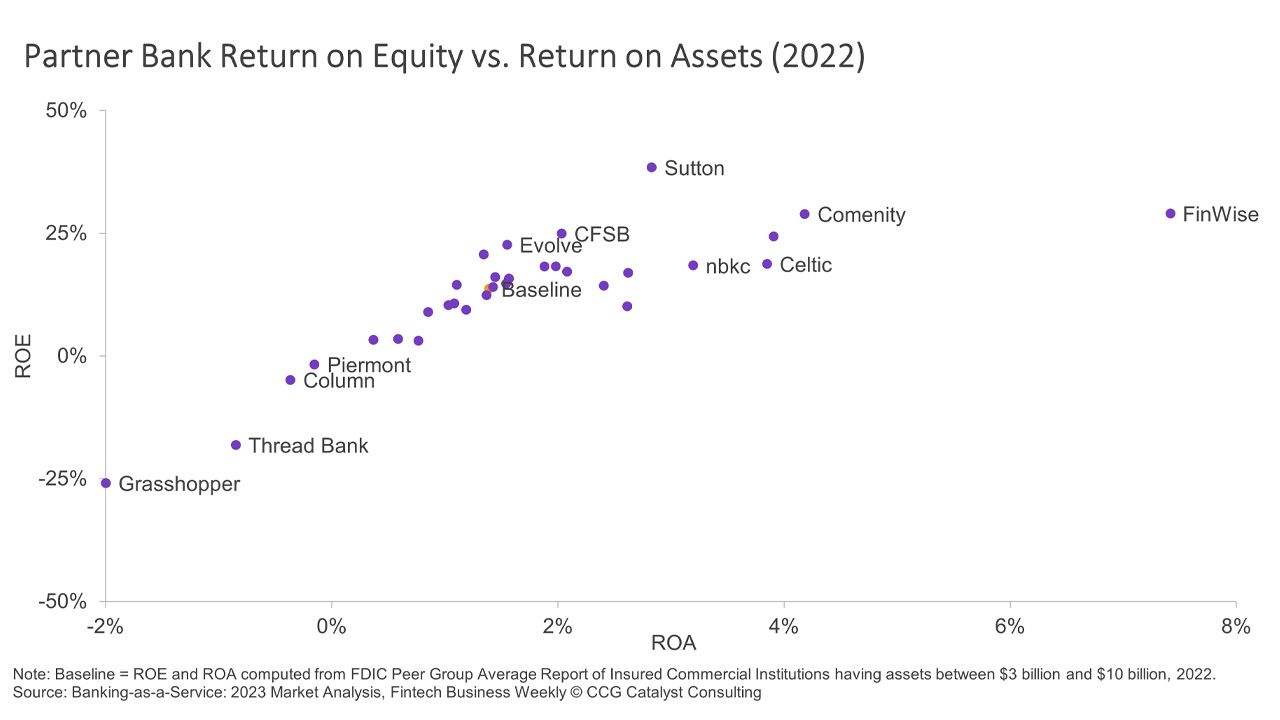BaaS Success Takes Time
March 2, 2023
By: Kate Drew
BaaS Bank Metrics
Perhaps no area of innovation in financial services sparked as much energy in the last few years as Banking-as-a-Service (BaaS). The model by which a chartered institution provides the regulatory umbrella necessary for a nonchartered company to offer financial services seemed like a perfect solution for many banks looking to generate new revenue streams in a tightening competitive environment, just as a slew of consumer-focused fintechs entered the market. We even saw a number of banks emerge specifically for this purpose. Now, as the fintech space cools and regulatory scrutiny increases, there is one burning question — is it worth it?
A new report from Fintech Business Weekly attempts to shed some light on this question — in particular, it includes an analysis of the performance of a number of banks in this market using return on equity (ROE) and return on assets (ROA) metrics. The analysis, which serves as an update to a similar probe published by a16z in 2020, demonstrates that, while BaaS can help an institution to generate better returns, this is not always the case. In fact, 13 of the banks analyzed had below average ROE. Moreover, it shows that those banks who seem to be benefiting the most are often those that have been around the space for a long time. So, is it worth it? Maybe, but it takes time. And, with that time, fine-tuning and experience. It also takes a lot of commitment — and investment. As Jason Mikula, publisher at Fintech Business Weekly and author of the report, told CCG Catalyst, “Banks newly entering the BaaS space may be enticed by the impressive profitability metrics of ones that have been operating such business models for a while — names like Bancorp, Pathward (formerly MetaBank), WebBank — but, if you look at the returns of newly formed banks or banks new to BaaS models, you realize it takes time and quality execution to achieve those returns.”
If the rose colored glasses weren’t off already, this should do it. But it’s also important to see the nuance and the potential opportunity that remains. The data doesn’t suggest that BaaS cannot be accretive to growth — quite the contrary. What it indicates, rather, is that it’s not an easy win. And it shouldn’t be approached that way. The past few years brought tremendous interest in this space, with many looking at BaaS as a way to move into the future without all the pain and worry about technology and transformation. Especially in the community banking sphere, BaaS was often talked about, as Mikula notes, “a silver bullet.” Everyone wanted a piece. Now, as this analysis indicates, it’s becoming clearer that BaaS isn’t a yellow brick road. We can’t all simply follow it to Oz. A bank that wants to pursue BaaS will need to carefully think through how this model fits with its strategy, the investment in resources it will have to make to do it effectively, and its ability to handle hiccups and learnings with agility.
Meanwhile, for those already part of the BaaS sphere, taking stock of your current programs is probably a worthwhile exercise, especially in light of tightening private capital and growing regulator interest. The biggest hurdle for these institutions will likely be figuring out how to adjust their strategies for a changing environment — one in which making the right choices is both harder and more important. Those that are able to separate the winners from the losers when deciding who to work with, and who can make themselves attractive enough to win clients with proven business models, still have a ton of room to run in this arena. However, that arena is also getting narrower — bets have to be sharper, and banks are going to be competing for a smaller pool of clients as greater diligence comes into play. But, more likely than not, these banks don’t need to be told that. The most successful ones already know what it takes.






